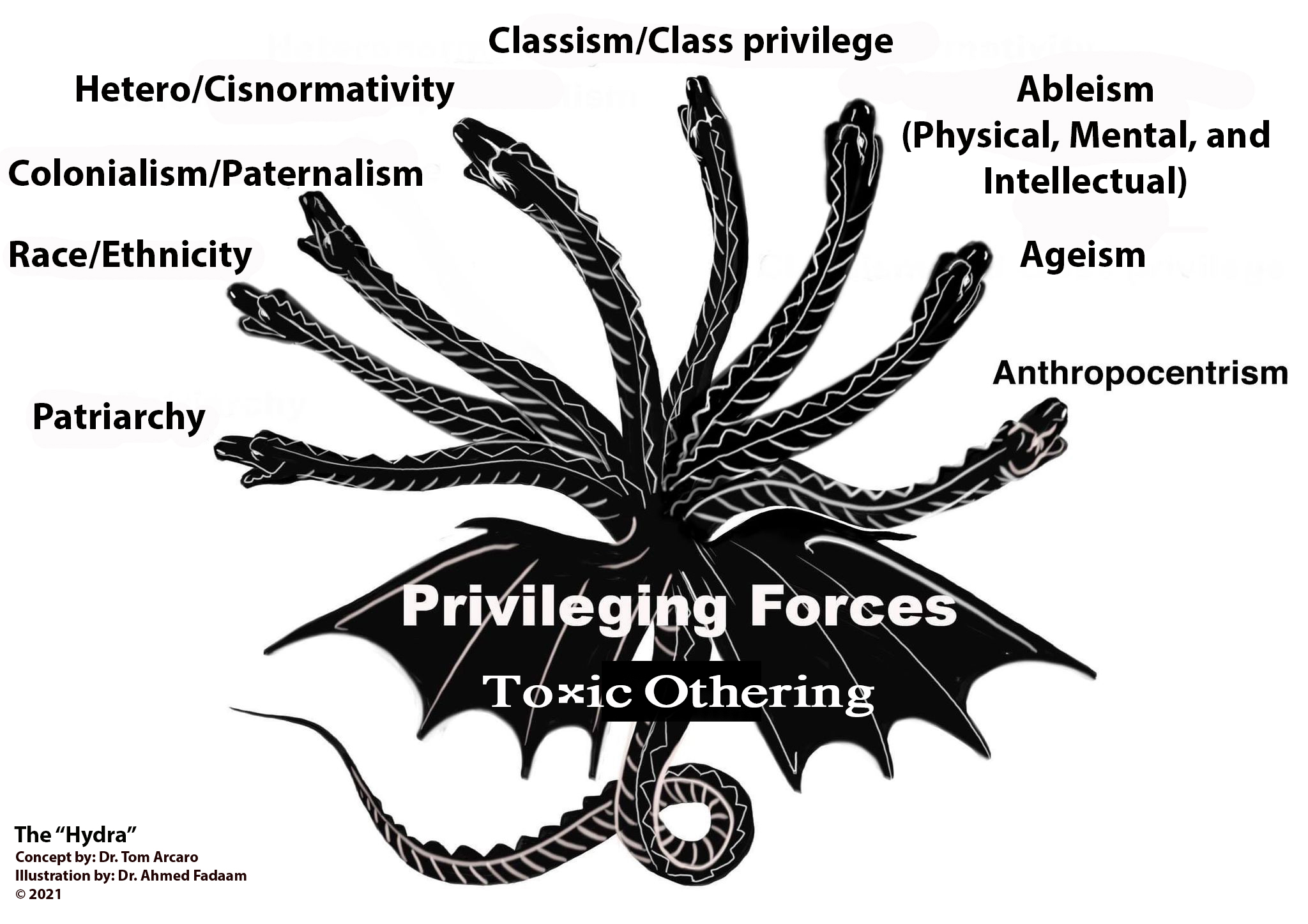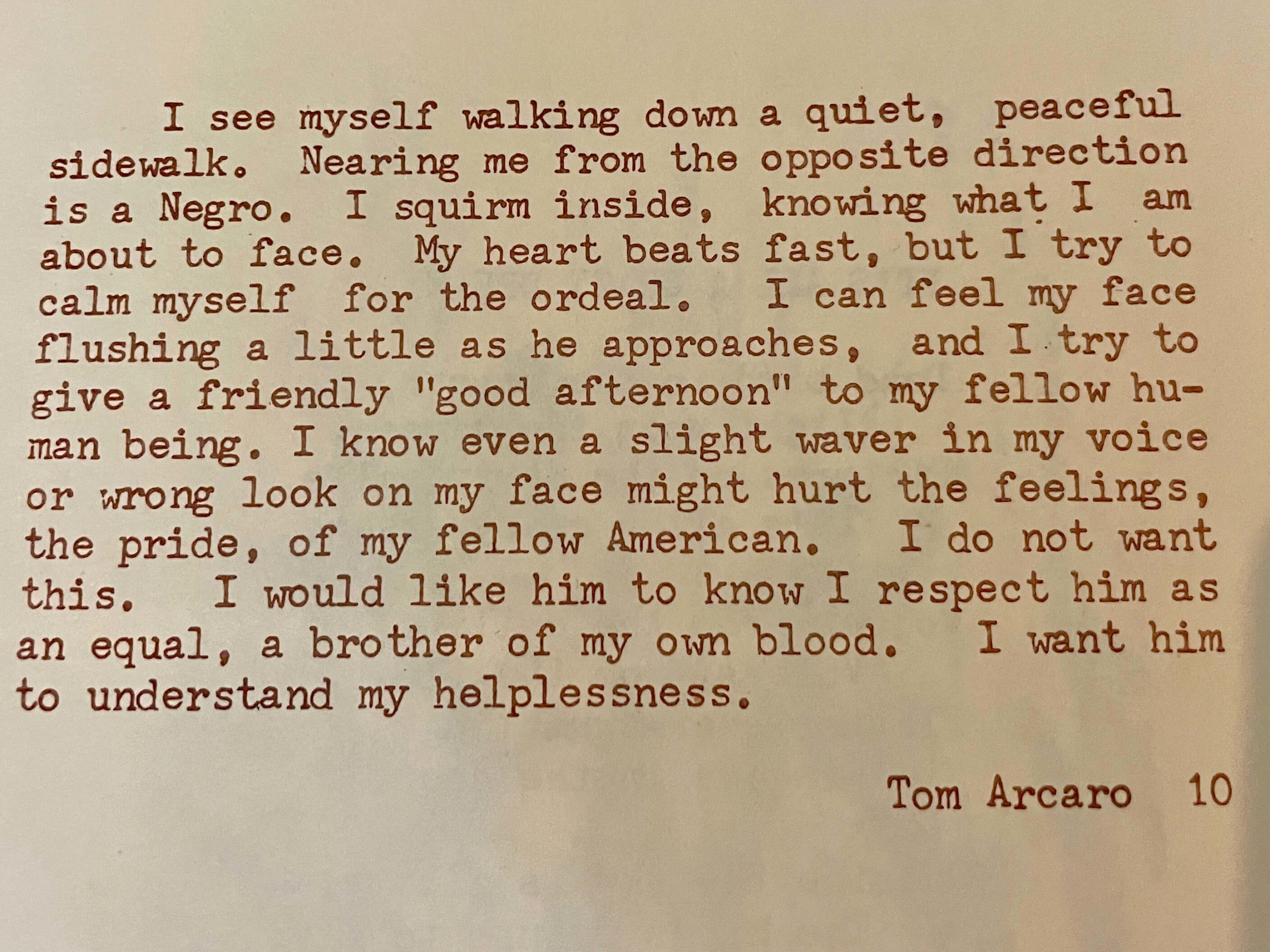‘…the inherent dignity and of the equal and inalienable rights of all members of the human family is the foundation of freedom, justice and peace in the world…
-from the first sentence of the Preamble to the 1948 Universal Declaration of Human Rights
[Updated 3-16-23]
[Trigger warning: Inherent in the nature of the material covered in this post are topics and exercises which may be triggering.]
Positionality and the Hydra
In my continuing journey to expand on what I have been calling ‘critical Hydra theory’ and to better understand privileging forces I have been thinking a good deal about positionality. Dimensions of our identity influence how we both see and are seen by others. This exercise is a companion to and should be done after exploring one’s status array.
Positionality can be defined as
“… the social and political context that creates our identity in terms of race, class, gender, sexuality, and ability status. Positionality also describes how your identity influences, and potentially biases, your understanding of and outlook on the world. Positionality asks people to understand and describe how gender and other identity markers [your status array] inform how we see the world around us.”
Though I agree completely with the wording in the above definition, I would expand it to include our entire status array including both ascribed and achieved statuses. I would also include understanding positionality is an absolutely essential step for effectively understanding and using critical Hydra theory on a personal level.
Here is my personal positionality statement which I have begun putting on all my course syllabi.
Personal positionality statement
I am a cisgendered, heterosexual, middle class, able (well, mostly), older white male, from and living in the global north (aka ‘too pale, too stale, too male’). But I am also a lifelong credentialed sociologist and student of power and how socially created, defined, and maintained power differences help create and sustain privileging social forces. I am still learning and growing, always striving to use my sociological perspective to increase both my self-awareness and my grasp of how privileging forces both historically and currently serve to marginalize those who are victims of toxic othering. Standing with Paulo Friere, my efforts are to understand oppression in its many forms, especially within my own behavior. My ongoing quest is to recognize, address, and confront how my (mostly privileged) ascribed statuses have impacted my life, perspectives, and interactions with others. Seeking to more fully understand my positionality, I make myself a student of thinkers and activists like Kimberlé Crenshaw, Patricia Hill Collins, John Lewis, Cornel West, and Angela Davis. I embrace this never-ending journey and know that I am not now -nor ever will be- completely free of all biases. As I move forward, feedback from you, my students, is critically important. I will accept this feedback with grace and my hope is this is the spirit in which it will be given. My we be a positive part of each other’s growth.
All humans have socially constructed status arrays that are comprised of both ascribed (e.g., race/ethnicity, gender, age) and achieved statuses (e.g., education, marital status) which change over time and from context to context. According to the Hydra model, our most salient ascribed statuses include gender/gender identity, race/ethnicity, colonial status, sexuality, social class, ability (including physical, mental, and cognitive), age, and our status as humans.
race/ethnicity, colonial status, sexuality, social class, ability (including physical, mental, and cognitive), age, and our status as humans.
We are a social species, largely defined by the cultural milieus in which we developed our sense of self and in which we currently work and live. Social status is just that, a status defined by our society; self and society are two heads of the same coin.
In my classical theory class each fall I spend some time on G.H. Mead’s ‘Mind, Self, and Society‘, the canonical work in the study of the interaction between self and society. In this work Mead talks about ‘taking the role of the other’, putting oneself in the position of the other and hence reflecting some degree of empathy. Awareness of one’s positionality, I believe, is an exercise in reflecting on our personal understanding of how we are socially created and sustained beings. This self awareness comes though constantly ‘taking the role of the other’. Importantly, this process of empathy also allows us to sense the positionality of those with whom we are interacting. That empathy is part of human nature perhaps explains the existence of a ‘Golden Rule’ ethos in virtually all world religions and thought systems.
Extending the concept of ‘taking the role of the other’, one of Mead’s colleagues, George H. Cooley, coined the phrase ‘looking-glass self’. He argues that at least in part one’s self identity comes from:
(1) imagining what others see when they see you,
(2) imagining how they evaluate or judge what they see when they see you, and
(3) incorporating these observations into one’s sense of self.
This ‘looking glass’ process supports the argument that self and society (those around us) are experientially connected. One hurdle is fully understanding this idea is that we tend to think of our self identity as more or less fixed and totally under our control. It is not. The sociologist Erving Goffman put it this way, “This special kind of institutional arrangement does not so much support the self as constitute it.” Though he was referring specifically to self identity within total institutions, his fundamental premise rings true.
Empathy is not unique to humans. We know from both human and non-human behavioral studies the level of empathetic capacity displayed by one individual can vary a good deal from others. Like many inherited traits (think height or intelligence), research evidence indicates that the capacity for empathy varies along a bell curve with most people within one standard deviation from the norm but with some two or more standard deviations from this norm; some people have an innately higher capacity for empathy, some, just the opposite, have a lower capacity for empathy. The cultures in which our minds develop do impact our behavior in terms of empathy, and tend to positively reinforce displays of empathy, though this is highly variable from one culture to the next. Indeed, human behavior can best be understood by looking at the complex interplay between our biology (‘human nature’) and cultural learning (‘nurture’).
A brother of my own blood
Late in the summer of 2022 I attended my Covid-delayed 50th (+2) high school reunion. Of the items on display at our dinner event were copies of ‘Potpourri‘, our high school’s yearly literary magazine. In the edition published during my sophomore year, 1968, I found a short writing of mine I had long forgotten. I discovered what amounts to a ‘positionality’ statement from over five decades ago. As a 15 year old raised in northeastern Ohio in the 1960’s, here were my thoughts:
Sadly, the pace of social change is at times glacial, and minus the dated language, what I wrote in 1968 reflects almost exactly my thoughts now in 2023. The county where I live in North Carolina still has a Confederate monument on the courthouse square.
I include this personal example to illustrate the point I made above, namely that we all ‘take the role of the other’ in most social encounters and are aware, at least at a subconscious level, of our positionality almost constantly. What I assumed in that moment was that what the other person (the “Negro”) saw was a white person and had every reason to believe that this white person was racist and hence felt superior, tending to marginalize him with any manner of subtle or not-so-subtle verbal or non-verbal communication. As it was in 1968 it still is now in 2023. Truly sad.
More notes on positionality
The Hydra model can be a useful tool when attempting to think and act more mindfully in a world characterized by the systemic marginalization of so many populations in every corner of the globe. Peace building and working for social justice go hand in hand.
Those who are aware of their own positionality and the privileging forces at play in their daily lives will be better equipped to integrate positive humanitarian and humanistic principles into their own lives. More deeply reflective and self aware individuals will thus be directly addressing and even confronting the many forms of toxic othering which fuel privileging forces and permeate virtually every social encounter.
An exercise
Here is an exercise intended to introduce the concept of positionality.
Describe your position within your family. How many siblings? What are their ages and genders? How many generations are in the household? You have a unique position within your family and it influences how you act and how others in your family interact with you. Most people would not speak in the same way to a parent as they would to a younger sibling of the opposite gender, for example. Though they may not think about it consciously, everyone is keenly aware of their positionality within their family and act accordingly.
Just as you are aware of your positionality within the context of your family, we all need to be aware of our positionality vis-a-vis co-workers, for example, and in all our social encounters. As discussed above, all humans have the capacity for empathy and just other capacities this varies within any human population; some people are more empathetic than others. Empathy leads to an awareness of one’s positionality in the work setting, and, just as in the family, this happens naturally, but typically not explicitly or even consciously.
A general principle of positionality awareness is that those who are in the status inferior (i.e., marginalized) positions tend to be more aware of their positionality than those in status superior positions. For example, in many workplace settings females tend to be very aware of misogynic or sexist behaviors while at the same time most males will be oblivious.
Awareness of one’s positionality allows for a greater awareness about how we may be engaging in behavior which marginalizes others and/or how our own behavior may have the impact of marginalizing others. Microaggressions are for the most part subtle but can have a huge impact on those being marginalized. An effective advocate for social justice is one who is sensitive to microaggressions and/or other acts of marginalization both as the victim and the perpetrator.
Critically important to understand is that in mixed social settings it is very likely that an individual can be both an oppressor and a victim of oppression. For example, a BIPOC male can be committing microaggressions toward females in the room when simultaneously having microaggressions being directed at him by non-BIPOC persons present. Being a good ally means constant vigilance regarding one’s status array and positionality and acting in a proactive manner to address all instances where marginalizing behavior is exhibited, both by oneself and others present.
Here are some questions to discuss:
- How does your positionality change from setting to setting during a typical day? For example, how does your status array compare with others in your work/school environment? On public transportation and other settings where you are anonymous? At home or in your neighborhood?
- What kinds of settings make you more aware of your positionality and status array? How does this awareness impact (if at all) your behavior?
- To what extent do you find yourself making an effort to be aware of other’s positionality and status arrays? What changes in behavior do you make (if any) as your awareness of your relative positionaliity increases?
- To what extent do the power and privilege ascribed to some statuses play a role in how you interact with others?
- Perhaps more relevant to school or work settings, to what to what extent does physical appearance or ‘pretty privilege’ play a role in social interaction?
As a final phase of this exercise, and after having done the status array exercise, each individual can be asked to write their own positionality statement.
Additional thoughts about positionality and social justice
Intersectionality, a term coined by and popularized by American legal scholar Kimberlé Crewshaw, must also be considered when raising one’s awareness of their status array and positionality. Crenshaw first used the term to describe the interaction between race and gender, but in her more recent writings she has stressed that all of our ascribed social statuses intersect as well (e.g., race and class, class and gender, etc.). The voices of those who are multiply marginalized are the best source for understanding this multi-layered intersectionality.
In the words of American author Ijeoma Oluo,
“The beauty of anti-racism is that you don’t have to be free of racism to be anti-racist. Anti-racism is the commitment to fight racism wherever you find it, including in yourself.”
Using the tool of critical Hydra theory (CHT), it may be useful to expand Oluo’s statement to include all of the toxic othering ‘isms’ including (but not limited to) sexism, colorism, homo/transphobia, classism, ageism, ableism, paternalism, colonialism, and so on. Consider replacing the word ‘anti-racism’ in Oluo’s statement with, for example, sexism or classism. Indeed, replace ‘anti-racism’ with any of the privileging forces represented by the heads of the Hydra.
The reality is that frequently we are both the oppressed and the oppressor, even in the same social situation. It is key to remember that we must fight oppression and marginalization as social forces and avoid focusing all our energies demonizing a specific ‘other’ who may be perpetuating a specific type of oppression. Our efforts should always be focused on addressing any false consciousness we may have (in other writing I refer to this as ‘baked in’ biases) and working to be anti-racist and ‘anti’ all of the other ‘isms’ mentioned above. One’s positionality fully considered always means understanding and addressing relevant forces of oppression at play in each social interaction, especially when asymmetries of power are a major factor.
Stated differently, using critical Hydra theory demands that we interrogate our past learning which has taught us how to be oppressed and also to oppress others. This is not an easy step, but it is one which might be facilitated by reading the words of Paulo Freire in his 1970 book Pedagogy of the Oppressed. In summarizing perhaps the main point of Friere’s cannonical book, researcher Anton Treuer says,
“Essentially what Freire has to say is that all forms of oppression have a pedagogy, a way by which we are all instructed and enculturated to accept and participate in dealing out the oppression and then receiving it, and often both. And he says because there’s actually a pedagogy for oppression there needs to be a pedagogy for the oppressed, a way to bring us into liberation.”
He goes on to add,
“So here are a couple of the really important things that I learned from Paulo Freire’s work. One is that oppression in all of its forms is complex and insidious and all of us– no matter how advantaged or disadvantaged we think we are– we all participate in the oppression.”
Listen to Friere himself,
‘Although the situation of oppression is a dehumanized and dehumanizing totality affecting both the oppressor and those whom they oppress, it is the latter who must, from their stifled humanity, wage for both the struggle for a fuller humanity; the oppressor, who is himself dehumanized because he dehumanizes others, is unable to lead this struggle.” (Pedagogy of the Oppressed, page 47)
The complicated and sometime treacherous journey toward social justice begins with greater self-awareness and has the ultimate goal of humanity’s liberation from all forms of oppression.
As humanity goes deeper into the 21st-century, the idea of most people having virtual identities and hence virtual status arrays has become a reality. We face a very uncertain future in terms of how the coming ‘metaverse’ will impact all of us regarding the various privileging forces and the process of toxic othering. One’s online presence is clearly a sophisticated product of impression management where an individual highlights typically or situationally positive aspects and dimensions of their social status and downplays others. This is an attempt to get a favorable relative positionality in whatever virtual social setting in which this person’s particular avatar exists. Of important note, and certainly relevant to my field of sociology, is that people can and do fabricate identities that may be quite unlike their real face to face identities they present in the ‘real’ world of social interaction.
In any case, my hope for the future is that technology and specifically online personalities and identities can serve as a force to mitigate toxic othering and not to enhance it. Only those with an accurate crystal ball can know for sure what the future holds in terms of how technology may impact social interaction and hence the forces which perpetuate oppression and marginalization. Being aware of one’s status array and how privileging forces are everywhere and impacting every human is difficult but important work. It is the work of those fighting for social justice.
My journey in using critical Hydra theory (CHT) and understanding toxic othering began with the observation that no human is inherently better than any other human. Working for a more just world where we all contribute to social conditions which preserve “…the inherent dignity … [and] the equal and inalienable rights of all members of the human family…” is my goal and I hope that it is yours as well.



 Follow
Follow